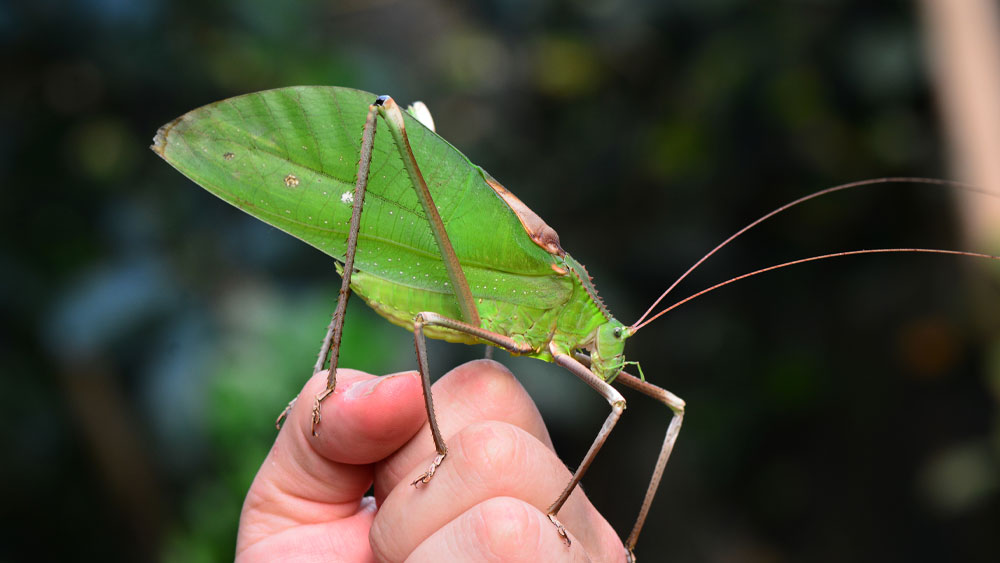A fascinating discovery of a fossil insect has recently been made by evolutionists in Colorado. The description once again points clearly to the effects of the Genesis Flood thousands of years ago.
50 million years ago in what is now northwestern Colorado, a katydid died, sank to the bottom of a lake and was quickly buried in fine sediments, where it remained until its compressed fossil was recovered in recent years. When researchers examined the fossil under a microscope, they saw that not only had many of the insect's hard structures been preserved in the compressed shale, so had several internal organs and tissues, which are not normally fossilized.1
The compressed shale was sedimentary rock laid down by running water that creationists suggest was part of the Genesis Flood 4,500 years ago. Indeed, the Colorado Formation, where the fossil katydid (family Tettigoniidae) was found, is part of the famous Green River Formation that also extends into Wyoming and Utah. This tristate Eocene formation was evidently formed by much more than just a local flood.2
Evolutionists understandably attempt to put a secular spin on this contemporary insect fossil discovery.
"Obviously, having a fossil species of a modern genus is really significant because it confirms the antiquity of this lineage," [Prairie Research Institute paleoentomologist Sam] Heads said. "Now we know that about 50 million years ago, this genus had already evolved and already had a morphology that mimics the grass in which it lives and hides from predators." The find will help scientists understand how this group of insects evolved and when they developed their unique physical structure, he said.1
The “antiquity” of this lineage is hardly confirmed! The only thing this fossil find tells scientists is this is a katydid just like the kind we find today. It says nothing about “how this group of insects evolved.” The specimen shows it had to be rapidly and catastrophically buried, “[b]ut perhaps the most striking feature of this fossil is the really exceptional, remarkable preservation of internal organs–organs that you just don’t see in fossils.”1 We do see remarkable and exceptional preservation of creatures, both of this fossil and increasing numbers of soft tissue ensconced within dinosaur fossils.3 Interestingly, original soft tissue has been found in none other than a Green River Formation fossil.4
Regardless, the public is expected to believe there has been no evolution (i.e. stasis) of this insect for 50 million years: “To double-check his analysis, Heads dissected several katydid specimens of the same genus [Arethaea] to match what he was seeing in the fossil. "They look exactly the same," he said.”1 Creationists are not surprised. Katydids have always been katydids. Paleontologists, however, cannot let go of, or even question, deep evolutionary time even when confronted with physical evidence such as this fossil.5-6
God designed the katydid, it has no evolutionary ancestors, and it was suddenly caught up and buried by the great Flood described in Genesis thousands of years ago.
References
- Yates, D. Ancient katydid fossil reveals muscles, digestive tract, glands and a testicle. Illinois News Bureau. Posted on news.illinois.edu June 26, 2023, accessed June 29, 2023.
- Tomkins, J. 2022. The Five Rules of Flood Paleontology. Acts & Facts. 51 (5).
- Thomas, B. Over a Dozen More Dinosaur Soft Tissues. Creation Science Update. Posted on ICR.org September 12, 2019, accessed June 30, 2023.
- Thomas, B. Green River Formation Fossil Has Original Soft Tissue. Creation Science Update. Posted on ICR.org May 12, 2011, accessed June 30, 2023.
- Sherwin, F. Physical Evidence Trumps Evolution Theory. Creation Science Update. Posted on ICR.org May 25, 2023, accessed June 30, 2023.
- Thomas, B. Mummified Dinosaur Skin Looks Young. Creation Science Update. Posted on ICR.org July 30, 2009, accessed June 30, 2023.
* Dr. Sherwin is science news writer at the Institute for Creation Research. He earned an M.A. in zoology from the University of Northern Colorado and received an Honorary Doctorate of Science from Pensacola Christian College.






















